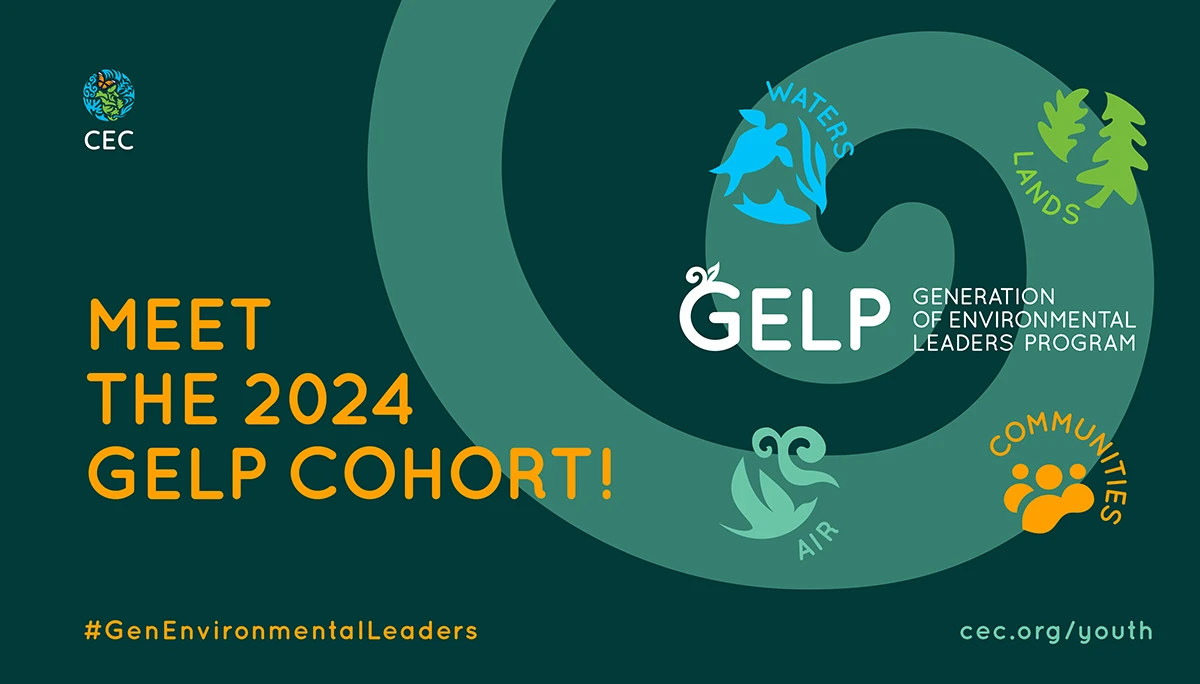First Cohort of CEC ‘Generation of Environmental Leaders Program’ Announced
Tiohtià:ke (Montreal), 20 June 2024—The Commission for Environmental Cooperation (CEC) is proud to announce the first cohort of the new Generation of Environmental Leaders Program (GELP).
The 2024 GELP cohort comprises three teams, each representing one of the following countries: Canada, Mexico, and the United States. The selected youth teams were chosen for their creative and impactful solutions to support North American communities and preserve our shared waters, lands, and air.
The GELP offers more than just a platform for ideas; it provides a year-long mentorship program, including public speaking, marketing and project management training, with guidance from many experts, and several networking opportunities. Each selected youth team receives C$15,000 in seed funding to amplify the impact of their solutions in local communities.
“We’re proud to introduce the very first GELP cohort, whose inspiring and forward-thinking solutions are already making an impact and addressing some of our most urgent social and environmental challenges. The GELP is a cornerstone of the CEC’s strategy and renewed efforts to meaningfully engage youth across North America,” said Julie Amina Jacquemin, CEC’s Outreach and Partnerships Lead.
The selected teams and their solutions are:
• Canada: Encore! Biomatériaux
Plastic pollution, inefficient food waste management, and the energy-intensive production of single-use plastic alternatives pose significant environmental challenges. In response, Encore! Biomatériaux devised an innovative solution: compostable packaging made from upcycled agri-food waste.
Their process started with extensive research into current environmental challenges and the untapped potential of upcycling agri-food waste. Laboratory tests then led to the development of a biosourced, biodegradable binding agent that serves as the foundation of their compostable packaging. Not only is their solution a low-energy-cost process, it also stands out for the versatility of the type of waste that can be upcycled, and for its operational simplicity.
• Mexico: Education for the restoration and conservation of the Tamasopo wetland
The Tamasopo wetland, nestled within the state of San Luis Potosí, is a designated Ramsar site of international importance threatened by pollution caused by agricultural and livestock raising activity. The wetland has undergone a distressing transformation, mainly due to the change in land use for sugarcane cultivation and the resulting contamination. A recent fire outbreak, sparked by crop burning for sugarcane harvest, engulfed half of the wetland’s surface, further exacerbating the situation and causing an alarming loss of biodiversity.
To counteract this decline, the youth team from Organización para Remediar el Medio Ambiente y Armonía Social A.C. proposes a comprehensive restoration effort of the wetland centered on environmental education, reforestation and conservation strategies. Following several field visits, a community engagement session took place to address the community’s needs and priorities. By fostering a collaborative approach and leveraging community-led initiatives, they aspire to initiate the gradual recovery of the Tamasopo wetland, safeguarding its biodiversity and ecological integrity for generations to come.
• United States: Electrivive: An Equitable Building Electrification Workforce Redevelopment Tool
In response to the pressing need for skilled labor in renewable energy, Electrivive emerges as an innovative educational resource, aiming to equip incarcerated individuals in regional jails with comprehensive training in building electrification. Developed in collaboration with partners such as Flipp Inc. and Indiana University Bloomington's H4I Energy Justice Lab, Electrivive's curriculum covers topics from energy-efficient building design to grid interactive solutions and smart control systems.
By providing participants with marketable skills and pathways to green careers, Electrivive aims to reduce recidivism and foster economic growth and environmental sustainability in Virginia's communities. Through workforce development, social justice, and environmental stewardship, Electrivive represents a beacon of hope for a brighter, greener future.
Click here to learn more about the 2024 GELP cohort and their solutions.
The GELP cohort will present their solutions to North America’s top environmental officials during the CEC’s annual Council Session and JPAC Public Forum, taking place 24–26 June 2024 in Wilmington, North Carolina, which is open to the public and livestreamed.
For more information on CEC youth initiatives and how you can be part of a collaborative network of young environmental leaders, please visit the Youth Initiatives section on our website.
Follow us on Facebook, Twitter, LinkedIn and Instagram and be part of the conversation, using the hashtags #ActNow, #GELP and #CEC31.
If you would like to know more about CEC initiatives, opportunities and efforts, you can sign up for our newsletter and follow us on social media.

About the CEC
The Commission for Environmental Cooperation (CEC) was established in 1994 by the governments of Canada, Mexico and the United States through the North American Agreement on Environmental Cooperation, a parallel environmental agreement to NAFTA. As of 2020, the CEC is recognized and maintained by the Environmental Cooperation Agreement, in parallel with the new Free Trade Agreement of North America. The CEC brings together a wide range of stakeholders, including the general public, Indigenous people, youth, nongovernmental organizations, academia, and the business sector, to seek solutions to protect North America’s shared environment while supporting sustainable development for the benefit of present and future generations
The CEC is governed and funded equally by the Government of Canada through Environment and Climate Change Canada, the Government of the United States of Mexico through the Secretaría de Medio Ambiente y Recursos Naturales, and the Government of the United States of America through the Environmental Protection Agency.